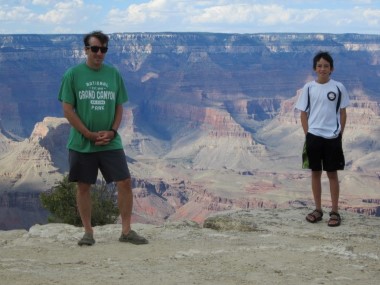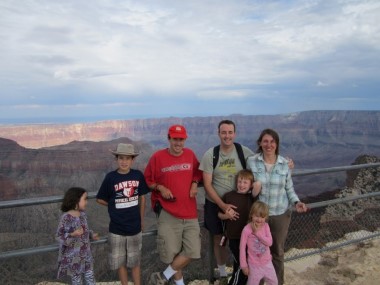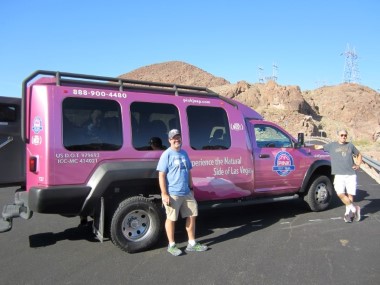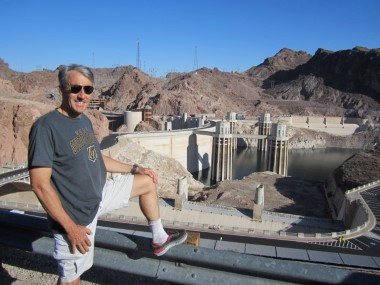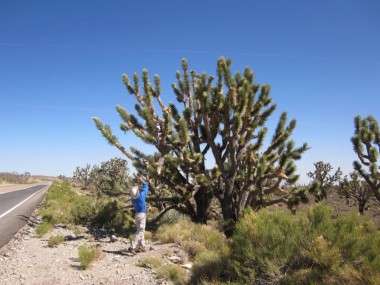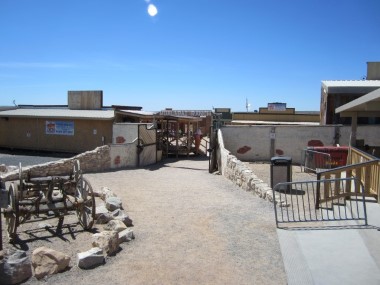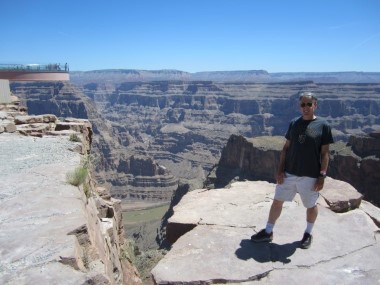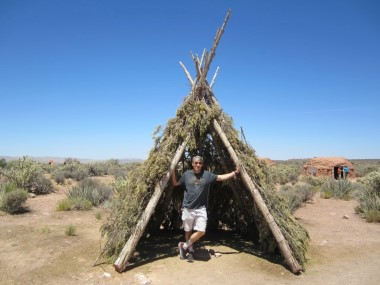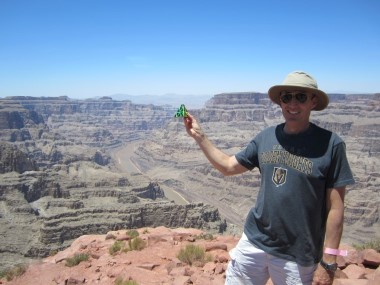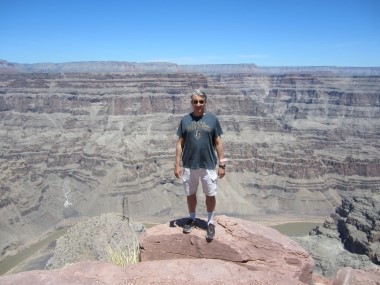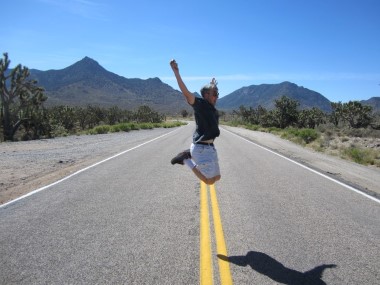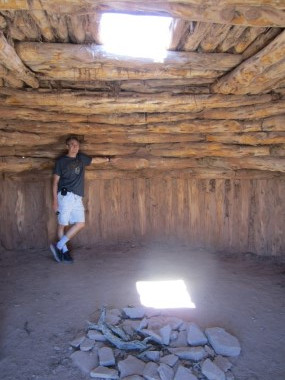Las Vegas is often described as a city in the middle of the desert with nothing much to see for hundreds of miles, except the shallow graves of casino cheats. This is simply not true. Within a four-hour drive of Las Vegas are some of our best national parks, namely Zion, Death Valley, and especially the Grand Canyon. All can be seen as a day trip from Las Vegas, albeit a long one. I could speak at length about all three, but this blog entry will focus on my recent visit to the West Rim of the Grand Canyon.
Before I get into my experience, let me go over some basics of the geography of the Grand Canyon. It is huge, thus the name. The section of the Colorado River that runs through it is 277 miles long. The size of the Grand Canyon National Park is 1,904 square miles, and there are large sections that belong to two native American tribes along the south side, as well. The West Rim of the Grand Canyon is located in such Native American tribal land. As a basis of comparison, Rhode Island is 64% the size at 1,212 square miles. Due to its immense size, there are various spots along the canyon rim tourists can take in views. Having hiked about 200 miles in the Grand Canyon, including hiking across it from south to north three times, rafting half of it, and camping on both the north and south sides as well as inside in the Havasupai campground, I feel well qualified to speak about it.
The vast majority of tourists visit the South Rim of the Grand Canyon. Part of the National Park, it contains plenty of hotels, restaurants, stores, campgrounds, transportation shuttles and hiking trails. The crowds can be heavy, and it can be a little confusing to navigate during your first visit. If you've never been to the Grand Canyon, but have seen images of the scenic overlooks on the rim, they are probably from the South Rim. When the Brady Bunch first took in the views from the rim, for example, it was from the South Rim, probably Mather Point. For most people, if you visit the Canyon just once in your life, I would recommend the South Rim.
South Rim
If big crowds are not your thing, the perfect flip side of that coin is the North Rim. It is much cooler and less crowded than the South Rim. It is cooler because it is 1,000 feet higher in elevation. For better or worse, there are much fewer tourist facilities on the North Rim and the viewpoints are spaced further apart, pretty much requiring a vehicle to get about. The North Rim is a great place to go camping or to have a relaxing stay in the lodge. If given the choice, which you pick could depend on where you're coming from and the time of year. The North Rim is only open from mid-May to mid-October, and while the two rims are a 25-mile hike apart across the canyon, it takes a little over four hours to drive from one side to the other.
North Rim
A third option is the so-called West Rim. I say "so-called" because it is located on the south side of the Colorado River. I suppose it is called the West Rim because "north" and "south" were taken and it is located on the western end of the Grand Canyon. As someone who is supposed to be a tourist resource about all things Vegas, I felt I had been remiss in my duties for having never done one of its most popular excursions by vehicle. After living in Vegas for 17 years, I finally remedied that with a day trip on June 11, 2018.
In the interests of full disclosure, Chris, a friend of mine and guide for Pink Jeep Tours, arranged a comp for the trip. He has done the West Rim tour hundreds of times. I previously shared with him some of the negative things I had heard about the West Rim and he assured me things had improved significantly in recent years, including a paved road the whole way, better organization, and less up-charging. He left me with no excuses to not give it a fair chance.
The drive from the Las Vegas Strip to the visitor center of the West Rim takes only two hours and 15 minutes, assuming no traffic issues. The distance from the Strip to the visitor center is only 75 miles as the crow flies. This makes visiting the West Rim by helicopter from Las Vegas a popular option, which I did several years ago. However, the vast majority of visitors come by car or on a tour.
The vehicles used by Pink Jeep for the West Rim tour could hardly be described as jeeps, but instead are spacious and luxurious passenger vans that hold up to 10 guests and a driver. Pink Jeep calls them “Trekkers.” The plush leather seats offer arms rests, cup holders, and plenty of leg room. On the way, Chris regaled us with information and trivia not just about the West Rim but also about Boulder City, Hoover Dam, the Mojave Desert, Joshua trees, and the small church-laden desert community of Dolan Springs, AZ. I am normally quick to match wits with anyone when it comes to trivia, but Chris seemed to know everything remotely related to the tour, from the anti-aircraft fortifications above Hoover Dam to bat poop.
Traveling in style at the Hoover Dam.
Along the way to the West Rim, we quickly visited the Hoover Dam, stopped at a roadside gift shop for a bathroom break, and checked out a Joshua tree forest. At this last stop, Chris obtained some edible Joshua tree seeds by throwing an umbrella at the fruits to knock them down. The time passed quickly and before you knew it, we entered the Hualapai tribe's land (has the term "Indian reservation" gone out of style?) where a very serious looking tribal police officer with a handgun waved us past, despite signage about having to stop for a security inspection.
Hoover Dam overlook on the Arizona side.
How to pick Joshua tree fruit.
We parked next to a busy airport, mostly for helicopters, and made our way to what I was told was a temporary visitor center while a new, permanent building was under construction. Contrary to reports I heard in the past, there was no fee to use the road nor to park. Pink Jeep guests had nothing to buy at this point, as the tour came with a wrist band that entitled us to entrance and lunch. If you come on your own, the basic entrance fee is $49.92 per person, at least at the time of this writing. There are various premium packages available at the point of entrance, which may include:
- The Skywalk • Dining — Both economy and "upscale"
- Hualapai tour guide
- Various helicopter and airplane tours
- Pontoon boat rides (available only with helicopter tours that land at the river)
- A zip line • Cabin rentals • Horseback, stagecoach, and wagon rides
You can try to book a helicopter trip at the last minute at the visitor center, but availability cannot not be guaranteed if you don't book in advance. Even if you do purchase in advance, it is known to happen that helicopter trips get canceled due to bad weather. The day of my visit, the skies were clear and the helicopters were going to and fro from the canyon like flying ants. While the parking lot was rather noisy due to the airport, one didn't notice the noise from the attractions on the rim.
Paying guests and guides exit the visitor center by a door leading to a quick queue to get on shuttle buses for the rim overlooks and attractions. Buses come every few minutes, and they filled to capacity on the day of my visit.
Shuttle Stop number one is the Hualapai Ranch. We didn't get out, but from the looks of it the Ranch is a kitschy tourist trap. If I wanted that, I could have made the short trip to Bonnie Springs, a simulated old west town just west of Las Vegas, several miles past the entrance to Red Rock Canyon. However, I'm jaded about such things. Perhaps others less cynical than me would like it.
Looking out the bus window at the Hualapai Ranch
Shuttle stop number two, Eagle Point, is the main attraction. This is home to the famous Skywalk, a glass, u-shaped bridge that extends thousands of feet above the canyon floor. If you decide to purchase a ticket to the Skywalk at the time of arrival, which is not included with the Pink Jeep tour, the cost is $21.65, including tax. Contrary to what I thought, the Skywalk looks directly down a side canyon, rather than over the Colorado River. The river is easily visible on the left side as you enter the Skywalk, however. Ever since the Skywalk opened in 2007, it has received a lot of hype in Las Vegas. Not just in advertising, but it has been in the news regarding fights over its ownership. As I understand it, the Hualapai tribe did a hostile takeover of it from the Chinese entrepreneur who financed it, but I'm sure the tribe has their version.
Eagle Point overlook with the Skywalk in the background.
To be perfectly honest with you, I was underwhelmed by the Skywalk. It was much smaller than my mental image from advertising. I suspect a wide-angle lens was used to make it look bigger than it really is. Plus, I've stood on glass-bottomed platforms high above the ground atop the Stratosphere and the Ghost Bar in Las Vegas, so that novelty had worn off for me. One can easily see the same views just outside the entrance to the Skywalk. You can decide, at that time, if you want to do it or not. I should mention that cameras, smart phones, and metal objects in general are strictly prohibitied on the Skywalk. Lockers are available for free to store them. Visitors must pass through a metal detector, to ensure they aren't sneaking a camera onto the Skywalk. At the time of my visit, Skywalk visitors could step right up after buying a ticket, but I have heard at other times queues can form. There was a short line, probably about ten minutes long, if you desired a photographer to do a quick shoot of your party. Signage could have been better that standing in the photography line was optional. Photo packages are, of course, available. Personally, I did the Skywalk mainly to say I did it, but I didn't have any pictures taken, so I apologize for the omission.
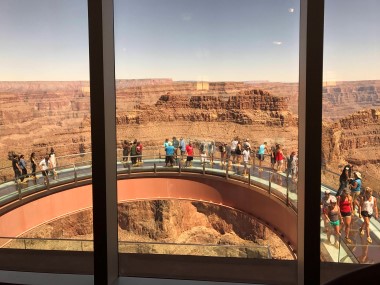
Skywalk. Photo by gamefreak.
Besides taking in the views and the Skywalk, Eagle Point offers a restaurant, Indian teepees and sweat lodges, intermittent entertainment (they were evidently on a lunch break at the time of my visit), and a gift shop. In the gift shop, I asked what I thought was a quick question on the difference between the Hualapai and Havasupai tribes. The person I asked happened to be a member of the Havasupai tribe and she happily explained, in great detail, the history of both tribes and when and why they split off into different bands. Then we discussed the various waterfalls in the village of Supai. She seemed very interested in my recent experience camping there.
Teepee at Eagle Point.
After seeing Eagle Point, we boarded the shuttle again for the third and final stop, Guano point. If you're wondering where you heard the word guano before, it is poop from sea birds and bats, which makes for good fertilizer. No, I am not guano crazy, it is true! There is a difficult-to-see cave on the opposite side of the river infested with bats that was recently mined for its guano. Remnants at the departure point of a cable system to the opposite side remain at Guano Point. There is a fight scene that took place on the cable car in the movie Edge of Eternity. The remnants of it at Guano Point looked like an eyesore to me, but it serves as a historical talking point for tour guides.
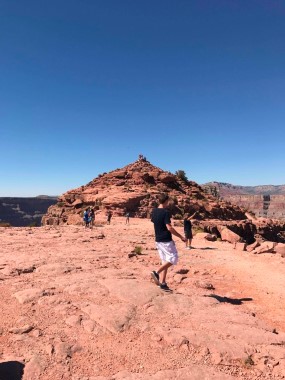
The "Ant Hill." Photo by gamefreak.
The views from Guano Point are much better than at Eagle Point. I think it is not a coincidence that the shuttle stops at the Skywalk first. Otherwise, I think guests would not be as inclined to pay for the Skywalk, given the better views they just had at Guano Point. I'll let these pictures speak for themselves.
My Pyraminx puzzle and me at Guano Point.
Near the shuttle stop there is an assembly-line operation for lunch, which was included in the Pink Jeep tour. The choices for the entree were shredded beef, chicken, and vegetarian. My advice is to not pick the shredded beef. One thing I have always wondered is why restaurants and buffets always overcook corn on the cob to the point where it has no flavor. The visit to the Guano Point chow line did not clear up this mystery.
Mike, take one step back.
Chris wisely allowed for plenty of time at Guano Point. Here we enjoyed the best views yet of the canyon from a peninsula that sticks out between two side canyons. There is an opportunity for some light rock scrambling, if you're into that kind of thing. The reward for reaching the top is a spectacular 180-degree view of the canyon.
Our fearless leader and I at Guano Point.
At the queue to get back on the bus, there were about a dozen tribe members selling jewelry and dream catchers displayed on folding tables. The prices seemed to be very reasonable, especially as compared to what you find in gift shops specializing in Indian crafts.
It was then back to the visitor center and the drive back to Vegas where Chris dropped off each guest at their hotel. Pink Jeep runs multiple trucks to the West Rim most days and aims to group passengers by their location on the Strip so the time spent picking up and dropping off guests is minimized.
The total tour time was ten hours. The cost is $269 through the Pink Jeep website ($243 for children) at the time of this writing.
All things considered, I would say the West Rim is a good taste of the Grand Canyon. I call it a "taste" partially because it is located near the western exit of the Grand Canyon, and thus not as deep as on the South and North Rims near the middle, and the views are not as "Grand." Nobody can argue with a straight face that the experience isn't better from either rim within the National Park, but you can't beat the convenience of the West Rim if coming from Las Vegas.
In conclusion, if you're in Vegas and have only one day to cross the Grand Canyon off your bucket list, go ahead and do the West Rim. I would not recommend making a day trip from Vegas to the South Rim and especially the north, because they are simply too far away, although such day tours are available to the South Rim. If you enjoy the West Rim, I would encourage you to think about doing a longer trip to the National Park during your next visit to the area.
My thanks to Chris and Pink Jeep Tours for an enjoyable and informative trip!
Jumping for joy on the road to the West Rim!
Internal Links:
- Trip report — by gamerfreak from my forum.
Terminology Comments:
Somebody wrote to me that my Native American terminology is at best outdated and at worst offensive. Here is a translation guide from this politically incorrect writer to the parlance of our times:
- Indian = Native American
- Indian reservation: I was only told to say "Native American" instead of Indian. I'm not sure if "reservation" is still kosher.
- Rock art = Rock stories
- Teepee = Native American dwelling
- Sweat lodge = Hogan
External Links:
- Grand Canyon West — Official web site
- Pink Jeep Tours — Official web site
- Grand Canyon statistics
- Hualapai Nation — Official web site
I think this is a sweat lodge, but I'm not sure.
Comments
Thanks Wizard! A great write up. Does the stop at the dam include the tour? Also, would you recommend this outing for older folks who may have canes, walkers, or wheel hairs?
Yes, the Pink Jeep tour of the West Rim includes about a 15-minute stop at Hoover Dam. They also offer a proper full Hoover Dam trip. On my tour there were three paying customers, including a woman who couldn't walk far and needed a little help getting into and out of the vehicle. She didn't get around as much as the rest of the group, but saw all the major views. You would have to contact Pink Jeep if more assistance than that is needed.
nice report Mike. Love the pics too
How is the air conditioning in those pink jeeps?
Is there a dining car on the mule train that descends into the canyon?
Native Americans? Hah! You think the Indians didn't come from somewhere else and force off the land whatever dwellers were already there? You think the various tribes didn't engage in constant warfare and seizing of captives? The Modocs in central California were a very violent slave-taking tribe and their high levels of throat cancer were due to the manner in which they made their oil and water bottles. So much for living in harmony with nature.



